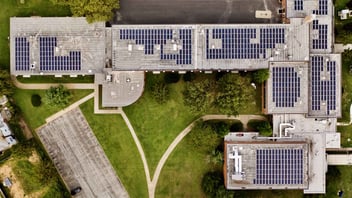How to Use Your Building in the Fight Against Climate Change

Buildings: Whether unremarkable or unforgettable, they’re an essential part of the infrastructure that enables us to live our lives. You’re probably making use of one right now. (If not, don’t forget your sunscreen!)
By design, buildings are often at their best when they go unnoticed, allowing us to work, play, relax, learn, and explore without interruption or inconvenience. But when it comes to consequences on our climate, the buildings operating in the background of our lives are making a massive impact that can’t fly under the radar any longer.
We owe it to our communities and the planet to examine the true weight of the built environment.
The Environmental Impact of Buildings
To say the spaces we occupy have consequences on the future of our environment is an understatement: When the many contributing factors are all taken into consideration, buildings are responsible for nearly 50% of global carbon emissions.
Ouch.
It’s a statistic that obviously needs to change if we want to preserve the planet that all we know and love. (It probably goes without saying, but… we really, really want that!)
So how do we build a world where buildings aren’t standing in the way?
Finding the Right Approach
There’s a well-known quote in architecture circles that says, “The greenest building is one that is already built.” We’re not claiming to be experts in architecture by any means, but it’s an instructive statement in addressing the environmental impact of our buildings.
The resources used to produce and transport raw materials, in combination with the massive energy needs and fossil fuel-driven output of any construction project, add up to create a heavy environmental cost.
While efforts toward minimizing the environmental impact of new construction are admirable and industry designations like LEED certification certainly have their place, it’s ill-advised to believe that the only—or best—option you have to reduce your building’s carbon emissions is by constructing a state-of-the-art new structure.
If brand new buildings aren’t the way to reduce the sector’s massive level of emissions, what is? Whether your building’s origins reach back a few years, a few decades, or even further, opportunities exist to make moves toward a more environmentally responsible existence.
How to Start Taking Action
Studies consistently suggest more than 25% of global carbon emissions come from building operations—not the construction requirements we outlined above, but the everyday demands of keeping the world’s buildings functioning as usual.
Fortunately, several strategies to reduce this type of emission are available for widespread implementation right now. They range from well-known and relatively straightforward options, like improving energy efficiency through more effective lighting fixtures, to broader cultural shifts that involve a greater awareness of daily energy use—such as developing more reliance on natural light, as opposed to your building’s electric lighting, during daylight hours.
One of the most significant opportunities to reduce a building’s emissions (and a step that’s essential if we hope to make our existing network of buildings sustainable over the long term) is making a transition to powering it with renewable, carbon-free energy sources.
Catalyst Power’s Connected Microgrid solution helps building owners to make this shift and enjoy a host of added benefits along the way. By bringing a solar installation right to your property, you’ll start generating clean energy on-site and immediately reduce the amount of power your building is drawing from the larger, fossil fuel-reliant energy grid each month.
As for those added benefits we mentioned? You’ll see your monthly energy spending drop as soon as your Connected Microgrid is up and running. In fact, when you sign your Power Purchase Agreement to bring a solar installation to your property, you’ll be locking in fixed lower energy rates for the duration of your agreement. Savings and stability—two big benefits to any business.
Plus, your Connected Microgrid will be built and operated at no cost to you. We’ll handle installation, as well as ongoing maintenance for the duration of its existence.
That’s right. Getting to work on improving your building’s environmental footprint doesn’t actually require… getting to work. That’s what we’re here for. All it takes from you is a few quick details that can be provided online, no lengthy enrollment process needed.
Let’s build a brighter, more responsible future together. Sign up to get started today!



.jpg?width=352&name=Untitled%20design%20(28).jpg)